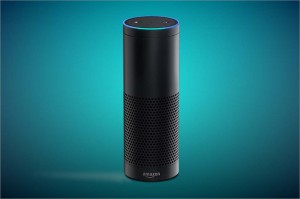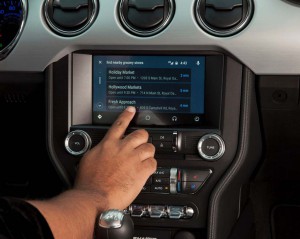
Ford CEO Mark Fields holds a downsized Velodyne LIDAR "puck" that will be used on Fusion autonomous vehicle prototypes.
Ford Motor Co. outlined a far-reaching step into the future during a keynote speech by CEO Mark Fields marking the opening of the 2016 Consumer Electronics Show in Las Vegas.
The maker is putting “one foot into the future,” said Fields, as it expands from traditional automotive manufacturing into new areas of “mobility,” such as ride and car-sharing. Among a variety of projects announced by Fields, Ford will partner with Amazon to incorporate the cloud-based voice assistant, Alexa into its vehicles. That would allow a driver to not just open a garage door but turn on lights and adjust the thermostat by voice command.
The Tuesday morning event notably included no mention of a widely anticipated tie-up between Ford and Google, even though the automaker announced a major expansion in its own autonomous vehicle program. But CEO Fields left the door open to a later announcement, stressing that Ford is talking with “a variety of other potential partners.”
A tie-up with Google could give Ford a real jump-start. Relatively late to begin developing autonomous technology, it is just beginning to put its prototypes out on public roads, but it says it will soon triple the number of test vehicles to 30.
Fields also stressed that once Ford does go to market with fully autonomous technology, capable of driving “in all locations under all weather conditions,” it will not focus on luxury buyers, like some competitors. Instead, “It will be a vehicle millions of people can afford.”
(Automakers turning CES into a high-tech car show. Click Here for the story.)
Under the youthful CEO, who took control in mid-2014, Ford has been increasingly focused on potential business opportunities that reach beyond just building and selling cars. That’s perhaps no surprise considering the traditional car business is worth about $2.3 trillion annually worldwide. The broader area of so-called transportation services rings up $5.4 trillion.
And it is encompassing more and more lines of business with the arrival of such concepts as car- and ride-sharing, and the rapid growth of in-vehicle connected services.
Among the many announcements Ford made at CES, it revealed updates coming for its latest-generation infotainment system, Sync – which it expects to be in 43 million vehicles by 2020. With the 2017 model-year the updated Sync3 will add Apple CarPlay and Android Auto features. And it will update its own AppLink system to expand the number of smartphone apps that will be accessible by voice command or through the car’s touchscreen.
Ford has turned over the underlying software behind AppLink to the open-source network, encouraging other automakers to turn it into a global, shareable standard. Toyota is the first to sign on, with other makers including Mazda and PSA Peugeot Citroen considering that option, as well.
(Toyota signs on for Ford’s new SmartDeviceLink. Click Here for more.)
Connectivity is becoming a critical part of the driving experience, whether for expanding infotainment options or to improve safety and security. The federal government is now considering mandating vehicle-to-vehicle and vehicle-to-infrastructure technology.
Meanwhile, cars are likely to become part of another network, the fast-expanding Internet-of-Things, or IoT. A study set to be released by research firm Gartner this week at CES predicts the average American home will soon have as many as 500 different devices linked to the Web. Ford could give motorists the opportunity to control many of those devices by partnering with Amazon.
The tech firm has seen an explosion of demand for its Echo speaker tower – which gives a user access to the Alexa voice assistant. In the near future, Ford owners may also tell Alexa to open their garage door or otherwise prepare the house for their return from work.
Ford is working on several partner projects that have potentially broader implications, including one pairing it with both the UN and Chinese drone maker DJI. The concept uses an F-150 pickup as a launching pad for drones that would be used to survey a disaster site, such as an earthquake or flood. The drones would automatically locate and land back in the bed of the pickup to recharge or when their mission ended.
Ford is by no means the only automaker exploring its options in the broader mobility arena. General Motors on Monday announced a $500 million investment in ride-sharing service Lyft.
(For more on the GM/Lyft deal, Click Here.)
And CES got off to a well-attended start on Monday evening with the official coming-out party for California-based – and Chinese-funded – auto start-up Faraday Future. The company declared its plan to rethink the traditional automotive model and take on competitors like Ford.
For his part, CEO Fields said, bring it on. “We can do it just as well as anybody else,” he said during an interview. “We’re really driving an innovation mindset in our company.”


